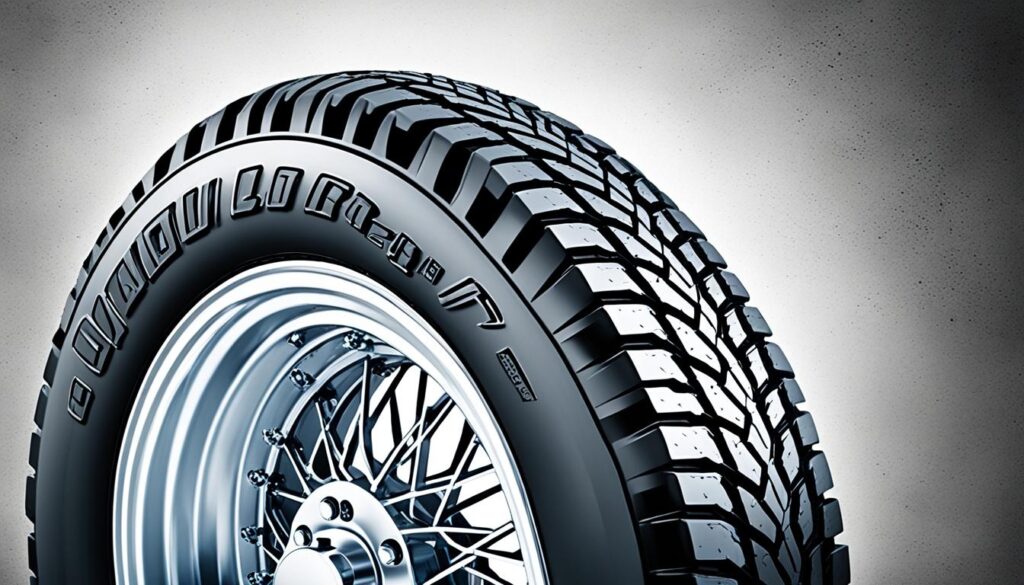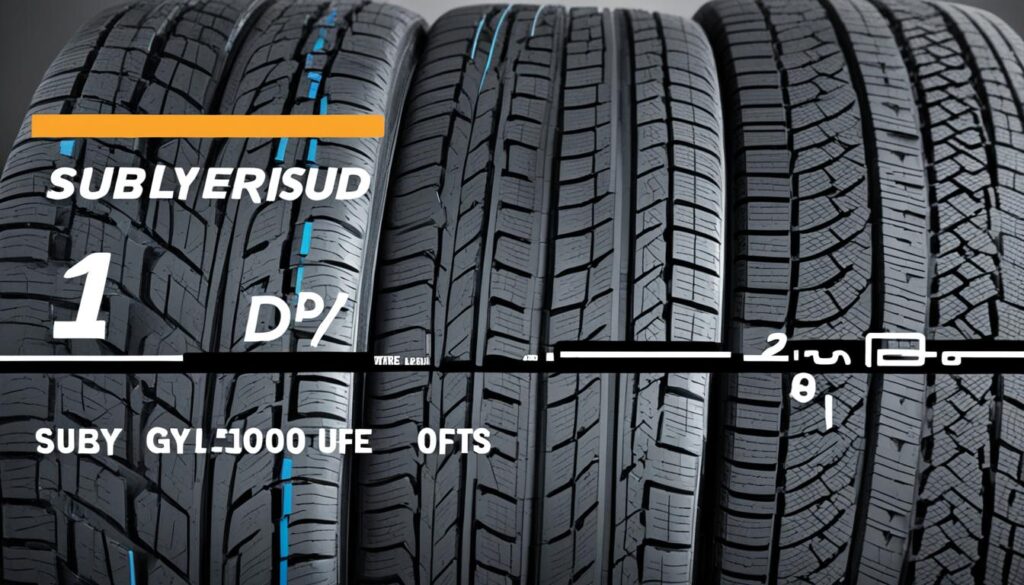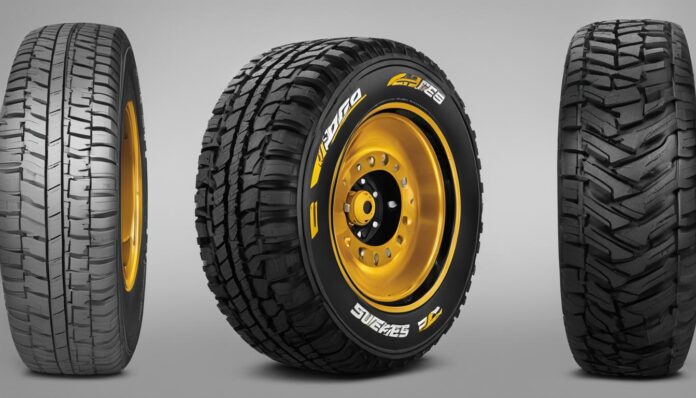As an Amazon Associate, I earn from qualifying purchases
Tires play a crucial role in the performance and safety of your vehicle. When it comes to choosing the right tires, understanding the differences between various ply ratings is essential. In this article, we will explore the distinctions between 4 ply and 10 ply tires, helping you make an informed decision for your vehicle’s needs.
Key Takeaways:
- 4 ply tires have four material layers that strengthen their sidewalls, providing increased durability and stability.
- 10 ply tires consist of ten layers of rubber-coated cloth cords, offering excellent load capacity and traction.
- The choice between 4 ply and 10 ply tires depends on factors such as vehicle usage, load capacity requirements, and intended road conditions.
- 4 ply tires are more suitable for light-duty applications, while 10 ply tires excel in heavy-duty and off-road scenarios.
- Consider factors such as cost, fuel efficiency, tire performance, and comfort when choosing the right ply rating for your vehicle.
What Is a 4 Ply Tire?
A 4 ply tire consists of four material layers that reinforce the sidewall. These layers, made of rubber-coated fabric cords, provide increased durability and resistance to punctures and cuts.
The multiple plies enhance stability, especially at higher speeds, and improve handling and cornering.
However, 4 ply tires may offer reduced ride comfort and generate more road noise. They are suitable for light-duty applications and light trucks or passenger cars.
| Features | Advantages | Disadvantages |
|---|---|---|
| Durability | • Increased resistance to punctures and cuts | • Reduced ride comfort |
| Stability | • Enhanced stability at higher speeds | • More road noise |
| Load Capacity | – | – |
When it comes to durability and stability, 4 ply tires offer reliability for everyday driving needs. However, their reduced ride comfort and road noise may not be ideal for long journeys or heavy loads.
What Is a 10 Ply Tire?
A 10 ply tire is a robust and durable tire that consists of ten layers of rubber-coated cloth cords. These additional layers provide strong support and increased load capacity, making 10 ply tires ideal for off-road or towing applications. They are commonly used in commercial vehicles, SUVs, and trucks that require exceptional strength and performance.
10 ply tires offer several benefits that cater to specific needs. Firstly, they provide better mileage by reducing weight without compromising stability. This means you can enjoy longer journeys without worrying about frequent tire replacements. The enhanced traction of 10 ply tires also makes them perfect for navigating off-road trails, ensuring maximum grip and control.
Furthermore, 10 ply tires exhibit exceptional load capacity, allowing them to handle heavier loads and tow heavy trailers with ease. Their construction is specifically designed to handle rigorous demands, making them a reliable choice for heavy-duty applications.
However, it’s important to note that 10 ply tires are heavier compared to lower ply ratings. The extra weight can impact fuel efficiency and road handling on uneven surfaces. It’s crucial to consider these factors when choosing the right tire for your vehicle.
Below is a visual representation of the features and benefits of a 10 ply tire:

| Features | Benefits |
|---|---|
| 10-layer construction | Provides strong support and increased load capacity |
| Better mileage | Reduces weight without sacrificing stability |
| Enhanced traction | Ideal for off-road trails |
| Great load capacity | Handles heavier loads and tows heavy trailers |
| Heavier weight | May impact fuel efficiency and road handling on uneven surfaces |
Which Is Better: 10 Ply or 4 Ply Tires?
The choice between 10 ply and 4 ply tires depends on your specific needs. If you frequently tow heavy loads or go off-road, 10 ply tires provide superior durability, strength, and load capacity. They are suitable for large pickup trucks, SUVs, and heavy-duty vehicles. On the other hand, 4 ply tires offer a more affordable and comfortable ride with less road noise. They are best suited for light trucks or passenger cars.
When choosing the right tire, it’s essential to consider your intended usage and prioritize factors such as durability, load capacity, performance, and comfort. If you require a tire that can handle heavy loads and challenging terrains, a 10 ply tire is the better option. It provides the necessary strength and durability to withstand the demands of towing and off-roading.
However, if you prioritize a comfortable ride experience and lower cost, a 4 ply tire is a suitable choice. It offers a smoother ride with reduced road noise, making it ideal for everyday driving and light-duty use.
Ultimately, the decision comes down to your specific requirements and preferences. Consider factors such as the type of vehicle you own, the load capacity you need, the driving conditions you frequently encounter, and your budget. By carefully weighing these factors, you can choose the tire that best meets your needs.
Cost Comparison
When considering the cost of tires, it’s essential to compare the prices of 10 ply and 4 ply tires. The ply rating directly impacts the price, as higher ply ratings usually come with a higher price tag. This is because 10 ply tires require additional layers and advanced technology to provide increased durability, load capacity, and resistance.
On the other hand, 4 ply tires are generally less expensive due to their simpler construction. However, it’s important to note that the lower cost of 4 ply tires may come with trade-offs in terms of durability and load capacity.
To make an informed decision, it’s crucial to consider the specific needs of your vehicle. If you own a heavy-duty vehicle or frequently engage in towing, investing in 10 ply tires may be necessary to ensure the necessary durability and load capacity. However, if you have a light truck or passenger car and do not require heavy-duty performance, 4 ply tires may provide a more cost-effective solution.
To illustrate the cost comparison, refer to the table below:
| Tire Type | Price Range (per tire) |
|---|---|
| 4 Ply Tires | $X – $Y |
| 10 Ply Tires | $Z – $W |
As the table demonstrates, 10 ply tires typically fall within a higher price range compared to 4 ply tires. However, it’s important to consider the overall value and suitability for your specific needs when making a tire purchasing decision.

Considering factors such as durability, load capacity, tread design, and cost will help you make an informed decision and select the right tires for your vehicle.
Mobility and Fuel Efficiency
The mobility of your vehicle is influenced by two key factors: the intended usage and the ply rating of the tires. Let’s explore how these factors can impact your vehicle’s performance and fuel efficiency.
Vehicle Mobility Based on Ply Rating
The ply rating of a tire indicates its load-carrying capacity and overall strength. When it comes to mobility, 4 ply tires are more suitable for light cars and driving on level surfaces. Their lower ply rating provides a balance between ride comfort and adequate performance for everyday driving needs.
On the other hand, 10 ply tires are commonly used in heavy-load vehicles such as trailers and trucks. These tires offer enhanced mobility in scenarios that involve transporting heavy goods or towing substantial loads. With their higher ply rating, they provide the necessary strength and durability to handle these demanding tasks.
Fuel Efficiency Considerations
In terms of fuel consumption, 4 ply tires generally offer better fuel efficiency statistics compared to 10 ply tires, especially in urban settings. The lighter construction and lower rolling resistance of 4 ply tires contribute to reduced fuel consumption, resulting in potential savings at the pump.
However, it’s important to note that 10 ply tires can also provide fuel efficiency benefits in their specific applications. With their superior load-carrying capacity, these tires offer better flexibility in heavy transportation, allowing for fewer trips and optimizing fuel consumption in situations where heavy loads need to be transported.
To summarize, while 4 ply tires tend to have better fuel consumption in general driving conditions, 10 ply tires can provide fuel efficiency advantages in heavy-load scenarios. It’s essential to consider your specific needs, intended usage, and the ply rating when making decisions about your vehicle’s mobility and fuel efficiency.
Conclusion
When it comes to choosing the right tire, several factors must be considered, including durability, load capacity, performance, comfort, cost, mobility, and fuel efficiency. In the 4 ply vs 10 ply tire comparison, each has its own strengths and suitability for different needs.
4 ply tires are more affordable and provide a comfortable and less noisy ride. They are suitable for everyday driving and light-duty use. These tires offer a balance between cost and performance, making them a popular choice for passenger cars and light trucks.
10 ply tires, on the other hand, offer superior durability, load capacity, and off-road capabilities. These heavy-duty tires are designed for towing heavy loads and navigating rough terrains. They provide the necessary strength and stability required by commercial vehicles, SUVs, and trucks.
Choosing the right tire ultimately depends on your specific needs and priorities. If you mostly drive on paved roads with lighter loads, 4 ply tires provide a cost-effective and comfortable solution. However, if you frequently tow heavy loads, venture off-road, or require enhanced durability, 10 ply tires are the better choice.
Consider the factors that matter most to you, such as performance, comfort, load capacity, and fuel efficiency, when making your decision. By evaluating these factors and choosing the appropriate ply rating, you can ensure optimal performance and safety for your vehicle.
FAQ
What are the differences between 4 ply and 10 ply tires?
4 ply tires consist of four material layers in the sidewall, offering increased durability and resistance to punctures and cuts. They provide stability and improved handling, but may result in reduced ride comfort and generate more road noise. In contrast, 10 ply tires have ten layers of rubber-coated cloth cords that provide strong support and increased load capacity. They are designed for off-road or towing applications and offer better mileage and traction. However, they are heavier and can impact fuel efficiency and road handling on uneven surfaces.
What are 4 ply tires?
4 ply tires have a 4 ply rating, which means they consist of four material layers in the sidewall. These layers, made of rubber-coated fabric cords, provide increased durability, resistance to punctures and cuts, stability, and improved handling. 4 ply tires are suitable for light-duty applications and are commonly used in light trucks or passenger cars.
What are 10 ply tires?
10 ply tires have a 10 ply rating, which means they consist of ten layers of rubber-coated cloth cords. These tires provide strong support, increased load capacity, better mileage, and enhanced traction. They are designed for off-road or towing applications and are commonly used in commercial vehicles, SUVs, and trucks.
Which is better: 10 ply or 4 ply tires?
The choice between 10 ply and 4 ply tires depends on your specific needs. 10 ply tires offer superior durability, strength, load capacity, and off-road capabilities, making them ideal for heavy-duty applications, towing, and off-roading. On the other hand, 4 ply tires provide a more affordable and comfortable ride with less road noise. They are best suited for light trucks or passenger cars. Consider your intended usage and prioritize factors such as durability, load capacity, performance, and comfort when choosing the right tire.
How do the costs of 10 ply and 4 ply tires compare?
The cost of 10 ply tires is generally higher than 4 ply tires due to the additional layers and advanced technology required for increased durability, load capacity, and resistance. 4 ply tires, while less expensive, may not be suitable for heavy-duty vehicles or towing. It’s important to consider the costs associated with each type of tire and the specific needs of your vehicle to make an informed decision.
How does ply rating affect vehicle mobility and fuel efficiency?
The mobility of your vehicle depends on the intended usage and the ply rating of the tires. 4 ply tires are suitable for light cars and level surfaces, while 10 ply tires are commonly used for heavy-load vehicles such as trailers and trucks. In terms of fuel efficiency, 4 ply tires tend to have better fuel consumption statistics compared to 10 ply tires, especially in urban settings. However, 10 ply tires offer better flexibility in heavy transportation, reducing the need for multiple trips and providing fuel efficiency in those specific scenarios.
What factors should I consider when choosing between 4 ply and 10 ply tires?
When choosing between 4 ply and 10 ply tires, it’s essential to consider factors such as desired durability, load capacity, performance, comfort, cost, mobility, and fuel efficiency. 4 ply tires are more affordable, provide a comfortable and less noisy ride, and are suitable for everyday driving and light-duty use. 10 ply tires offer superior durability, load capacity, and off-road capabilities, making them ideal for heavy-duty applications, towing, and off-roading. Consider your specific needs and prioritize the factors that matter most to you when making a decision.
